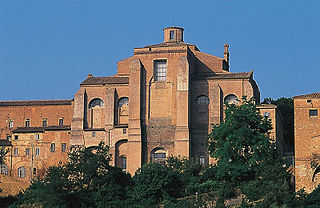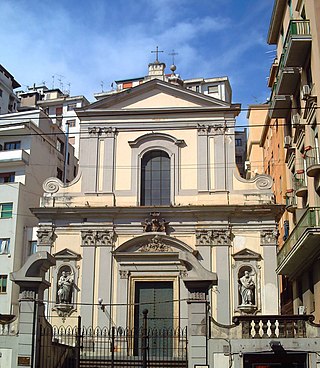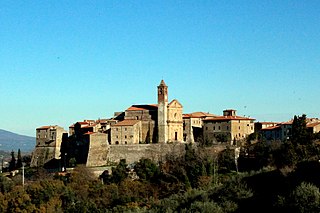
The chiesa di Sant'Agostino is the second largest church in San Gimignano, Italy, after the Collegiata. It is owned by the Order of Saint Augustine.

Sant'Eustachio is the 8th rione of Rome, identified by the initials R. VIII. It is named after the eponymous church and is located within the Municipio I.

The Basilica of St. Augustine in Campo Marzio, commonly known as Basilica of St. Augustine and Sant'Agostino, is a Roman Catholic titular minor basilica dedicated to Saint Augustine of Hippo. It is the mother church of the Order of Saint Augustine and it is located just northeast of the Piazza Navona in the rione of Sant'Eustachio in Rome, Italy.

Płock Cathedral, or the Cathedral of the Blessed Virgin Mary of Masovia, is a Roman Catholic cathedral in the city of Płock, in central Poland. It is an example of 12th-century Romanesque architecture and is the oldest and most important historical monument in the city, which contains the tombs of several Polish monarchs. It is listed as a Historic Monument of Poland.

The Church of the Eremitani, or Church of the Hermits, is a former-Augustinian, 13th-century Gothic-style church in Padua, region of the Veneto, Italy. It is also now notable for being adjacent to the Cappella Scrovegni with Giotto frescoes and the municipal archeology and art gallery: the Musei Civici agli Eremitani, which is housed in the former Augustinian monastery located to the left of the entrance.

Sant'Agostino is a Roman Catholic church in Siena, region of Tuscany, Italy.

Christianity and religion in general has always been an important part of the social and cultural life of Naples. It is the seat of the Archdiocese of Naples, and the Catholic faith is highly important to the people of Naples and there are hundreds of historic churches in the city. The Cathedral of Naples is the most important place of worship in the city, each year on September 19 it hosts the Miracle of Saint Januarius, the city's patron saint. In the miracle which thousands of Neapolitans flock to witness, the dried blood of Januarius is said to turn to liquid when brought close to relics said to be of his body: this is one of the most important traditions for Neapolitans.
Sant'Agostino or Santagostino may refer to:

Giuseppe Sanmartino or Giuseppe Sammartino was an Italian sculptor during the Rococo period.

The Zecca is a sixteenth-century building in Venice, Italy which once housed the mint of the Republic of Venice. Built between 1536 and 1548, the heavily rusticated stone structure, originally with only two floors, was designed by Jacopo Sansovino in place of an earlier mint specifically to ensure safety from fire and to provide adequate security for the silver and gold deposits. Giorgio Vasari considered it the finest, richest, and strongest of Sansovino's buildings.

The church of the Santissima Trinità alla Cesarea is a Baroque-style church, located in Piazetta Trinità alla Cesarea, in central Naples, Italy.

San Giorgio dei Genovesi is a church on Via Medina in the Center of Naples, Italy. It is adjacent and just north of the Church of the Santa Maria Incoronata, two doors south from the Palazzo d’Aquino di Caramanico, and across the street from the Church of the Pietà dei Turchini.
Evangelista Schiano was an Italian painter, mainly of sacred subjects.

Caldana is a village in Tuscany, central Italy, administratively a frazione of the comune of Gavorrano, province of Grosseto. At the time of the 2001 census its population amounted to 980.

Tirli is a village in Tuscany, central Italy, administratively a frazione of the comune of Castiglione della Pescaia, province of Grosseto. At the time of the 2001 census its population amounted to 284.

Chiesa Parrocchiale di Sant'Agostino is a Roman Catholic parish church on Piazza Sant'Agostino in central Modena, Italy.

Santa Maria Egiziaca a Pizzofalcone is a Baroque-style, Roman Catholic, Basilica church on the street of the titular name in the hill of Pizzofalcone, in the historic center of Naples, region of Campania, Italy. The church layout was initially designed by Cosimo Fanzago.

Bartolomeo Picchiatti was an Italian engineer and architect. A short street in the Soccavo area of the city is named after him.

Santa Rita in San'Agostino, sometimes just called Sant'Agostino, is a Roman Catholic parish church and sanctuary, located on Via Vittorio Emanuele II #318, in Catania, region of Sicily, southern Italy. The church was formerly attached to an Augustinian convent, and known as Sant'Agostino. But in the 20th century was dedicated as a sanctuary to Santa Rita of Cascia.
The Via Flacca was a Roman road along the western coast of Latium, Italy. It was built under censor Lucius Valerius Flaccus around 184 BC. Parts of it have recently been renovated as a trekking route.

















